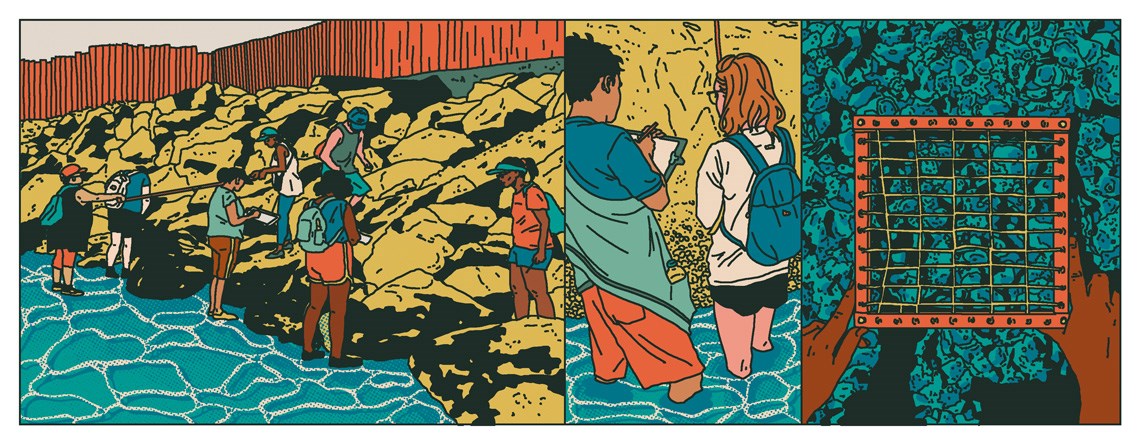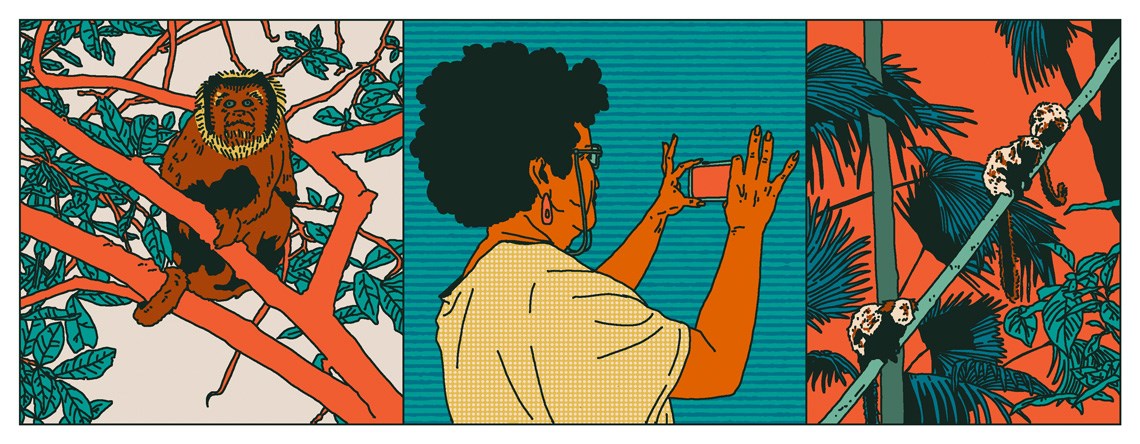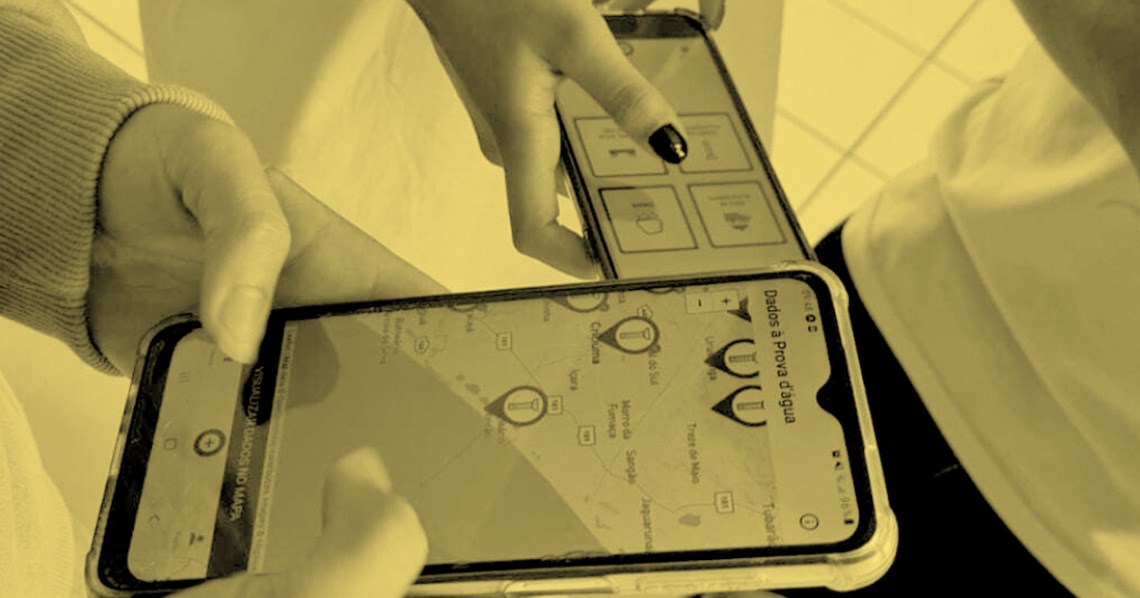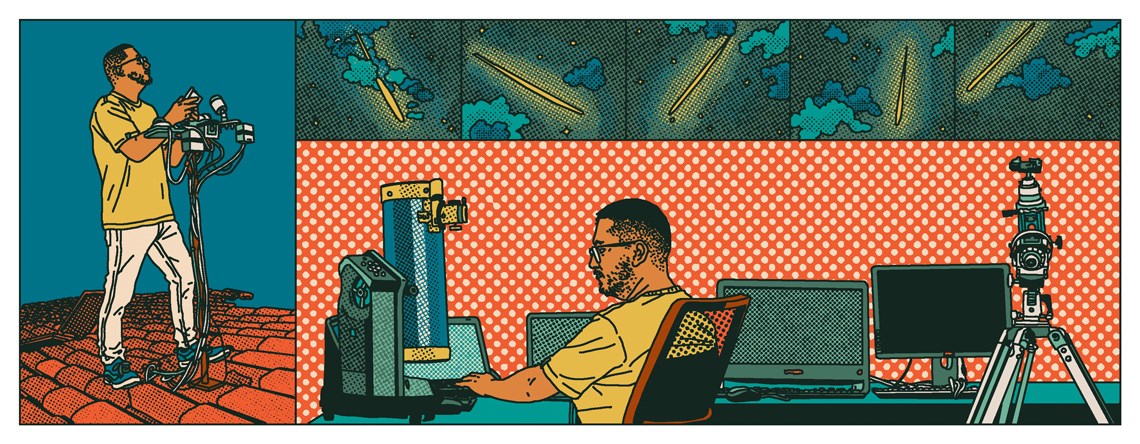Biologist Ronaldo Christofoletti was not in the habit of giving interviews in front of TV cameras, but that was before he invited residents of Baixada Santista, on the coast of São Paulo, to be his research partners. “The local press wanted to understand what we were doing and how it was possible for individuals with no experience in fieldwork to produce scientific knowledge,” says the professor from the Sea Institute at the Federal University of São Paulo (UNIFESP). In 2019, he and his team recruited 51 people to help map the distribution of marine species on rocky coastlines. The diverse group included undergraduate students, professionals with degrees in geography and biology, primary school teachers, retirees, environmental technicians, engineers, and journalists, all of whom signed up as volunteers online. Armed with quadrats (square metal frames used to isolate areas on the ground in which to study plants and animals), data sheets, and cameras, they traveled around the beaches of Urubuqueçaba Island in Santos, keeping a record of the organisms they found along the way. The data were then given to the researchers, who compared them with records from professional scientists to assess the accuracy of the participants’ results.
The project led by Christofoletti sought to study and promote a movement known as citizen science and its associated methodologies, through which members of the public with no scientific experience participate in research. The practice still faces numerous challenges, but it has been gaining a foothold in Brazil. Several citizen science initiatives have emerged in recent years, allowing amateurs to help survey and monitor the ecological patterns of plant and animal species, the spread of disease vectors, air quality in major cities, meteors in space, and various other research topics.
The approach has also attracted the attention of funding agencies and teaching and research institutions in the country. At the end of 2019, the University of São Paulo (USP) and Santander Bank launched a R$180,000 public call for proposals to fund projects that planned to adopt the model; eight were selected. One of them, led by Sheina Koffler, a biologist on a postdoctoral fellowship at USP’s Institute for Advanced Studies, relies on the help of stingless bee breeders to determine areas where the mite Leptus sp., which infects the bees, is found and thus evaluate its impact on the conservation of these pollinating insects. In August 2022, the Brazilian National Council for Scientific and Technological Development (CNPq) announced a R$3 million call for citizen science proposals within the scope of oceanography programs and studies on Antarctica overseen by Brazil’s Ministry of Science, Technology, and Innovation (MCTI).
The same drive is taking place in various other countries. Environmental protection agencies in the USA and Scotland, for example, have already incorporated citizen science into some of their projects, while the United Nations Environment Program (UNEP) is exploring ways to utilize the approach to monitor progress toward its environmental Sustainable Development Goals (SDGs). “It is impossible to track global progress towards these goals using traditional data sources alone,” wrote Jillian Campbell, a UNEP statistician, in a 2019 article in Nature Sustainability. Data generated by people with no research experience can help in this regard, according to an article published in Sustainability Science in 2020 citing ways in which citizen science has contributed to monitoring SDG indicators.

Eduardo Cesar / Revista Pesquisa FAPESPAmateur bird watchers participate in research activities at the Butantan Institute, São PauloEduardo Cesar / Revista Pesquisa FAPESP
The European Commission has also invested in projects of this nature through its Horizon 2020 research and innovation program. At least 25 initiatives have received over €65 million in funding from the Science with and for Society program in recent years.
The term “citizen science” first came into use in the early 1990s, but its meaning encompasses a much older practice. There are historical records of contributions made by amateurs to the production of knowledge in fields such as astronomy, botany, geology, and others. “There wasn’t always a formal distinction between who could and could not do science,” explains Sarita Albagli, a sociologist from the Brazilian Institute of Information in Science and Technology (IBICT). The situation only changed in the nineteenth century, when scientific research was established as a professional vocation only to be carried out by trained invididuals. This perspective began to be revised in the 1960s, based on a debate about the image of science as an objective pursuit of the truth, regardless of the consequences. “Gradually, it started to be seen as a socially constructed activity,” says Albagli. The discussion about expertise heated up in the 1980s, with a focus on the notion that people without formal scientific training also have valid knowledge acquired from their own experiences, and that this can be useful.
One of the main benefits of public collaboration in research is that it can generate information that may not be obtainable in any other way, partly because through citizen science initiatives, volunteers can collect large data volumes over long periods of time and large areas. Involving nonspecialists can also inspire new approaches, allowing scientists to investigate specific issues or problems faced by the participants, producing results with direct and immediate impacts on their lives. The approach could even help to improve the scientific article review process in some areas. Some journals have invited patients and their carers to help review papers about their health problems as a complement to the scrutiny of specialists (see Pesquisa FAPESP issue no. 270).
This form of collaboration also has other ambitions. In many cases, the initiatives are designed to promote scientific literacy and train future researchers. “In times of scientific denialism, citizen science helps fight disinformation, encourages critical thinking, and increases society’s trust in science,” says ecologist Blandina Felipe Viana of the Institute of Biology at the Federal University of Bahia (UFBA). Viana is cofounder of Guardiões da Chapada, a project created at the National Institute of Science and Technology for Interdisciplinary and Transdisciplinary Ecology and Evolution Studies (INCT IN-Tree) through which volunteers monitor the interactions between plants and pollinators in natural, urban, and agricultural environments by submitting photographs via a mobile app and the Guardiões da Biodiversidade website.
 Ing Lee
Ing Lee
There is evidence that citizen science can produce data useful to decision-making and the creation of public policies. At Brazil’s National Center for Natural Disasters Monitoring (CEMADEN), the work of information scientists, geologists, meteorologists, and high school students from around the country was used to create an app that warns people of flood risks in vulnerable areas.
The idea was born from a previous project called CEMADEN Educação, launched in 2014 at schools in the São Paulo municipalities of São Luiz do Paraitinga, Cunha, Vale do Paraíba, and Ubatuba, with the aim of disseminating a culture of environmental research and education among students, and thus engaging them in the task of monitoring the risk of disasters, especially those caused by heavy rainfall. “We wanted to transform them into young researchers, capable of collecting data and then using this data to monitor tragedies in the regions where they lived,” says sociologist Victor Marchezini, one of the coordinators of the initiative.
The project was divided into three stages. First, the students took part in a training course on how to collect historical data and conduct interviews with older residents about past disasters and socioenvironmental changes. They then used this information to map high-risk areas and identify emergency evacuation routes. Then, CEMADEN meteorologists taught them how to turn used plastic bottles into homemade rain gauges to measure rainfall levels. The students used this data to create a monitoring table on historical rainfall volumes at different times of the year.
The initiative caught the attention of other institutions interested in starting similar projects. One was Dados à Prova D’Água, developed in collaboration by the Getulio Vargas Foundation (FGV) in São Paulo, the universities of Glasgow and Warwick in the UK, and Heidelberg University in Germany. The aim was to build an app through which students could share data on floods, rainfall, and river water levels, as well as information on areas at risk. “We used the previous activities as a guide to train the new students and teach them how to build homemade rain gauges,” explains Marchezini. “They were then responsible for checking the rainfall every day and entering the data into the app.”

Léo Ramos Chaves / Revista Pesquisa FAPESPFrom his home in Sorocaba, stingless bee keeper Vilmar Ferreira da Silva contributes to a USP study on a species of parasitic mite that attacks the insectsLéo Ramos Chaves / Revista Pesquisa FAPESP
The approach was tested in the cities of São Paulo and Rio Branco, Acre, and later in municipalities in the states of Pernambuco, Santa Catarina, and Mato Grosso, with positive results. In Jaboatão dos Guararapes, part of the Recife Metropolitan Area, some residents that participated in the application’s pilot continued using the tool after the study was completed. In May, one of them used it to warn that rainfall had been higher than expected in the region where he lived, triggering a response that eventually led to evacuation of the area at risk.
Another example of a successful citizen science project is Exoss Citizen Science, created in 2015 by professional and amateur astronomers interested in studying meteors. “Amateur astronomy is nothing new, but it has grown in popularity alongside the falling cost of surveillance cameras, which are easily adapted for this purpose,” explains Marcelo De Cicco of the Brazilian National Institute of Metrology, Quality, and Technology (INMETRO), who leads the project. “Some colleagues and I then decided to use social media to teach other interested parties how to monitor these phenomena, sharing tutorials on how to adapt and install the equipment.”
That is how Adriano Fonseca, 44, found out about the initiative. He contacted De Cicco in 2020 expressing his interest in setting up a monitoring station at his home in Sorocaba after seeing a post by the group on Facebook. Fonseca has a degree in automation engineering but is an astronomy enthusiast and has invested his own money in telescopes and cameras to observe the Milky Way. “I wanted to work more closely with physicists and astronomers to learn more about how they track these celestial objects and calculate their orbits,” he says.
The project developed into a large network of observers, with more than 50 active cameras nationwide—five of them on the roof of Fonseca’s house. Volunteers keep them pointed at the sky and turn them on at the end of each afternoon to record rapid movements at night. The data are stored, pre-analyzed by software, and uploaded to a server. “The cameras are installed such that each one complements another’s field of view, allowing us to triangulate the images and calculate a meteor’s origin, speed, and orbit,” explains De Cicco. Thanks to the participation of volunteers, the network was able to record several fireballs and meteor showers across the country’s skies. Many of these events were presented at national and international conferences, contributing to the work of researchers from traditional institutions, such as the National Observatory in Rio de Janeiro.
 Ing Lee
Ing Lee
Most citizen science projects, however, are linked to the environment, a field where the model has prospered in Brazil, especially since 2017, when the SiBBr Network was launched as part of the federal government’s Brazilian Biodiversity Information System, with the aim of uniting and publicizing collaborative biodiversity initiatives. More than 40 projects have been registered on the platform since it was established. The most common approach is for “citizen observers” to record animal and plant species. This strategy is of particular interest to scientists because it allows data to be collected across large distances, which is useful in comprehensive studies on the areas of occurrence or population sizes of certain species.
One example is the “Eu vi um macaco no mato” (“I saw a monkey in the forest”) project. The objective was to monitor primates in Santa Teresa, Espírito Santo, one of the regions most impacted by the yellow fever epidemic between 2016 and 2018. “Several species were affected by the disease; some even went extinct locally,” says Andresa Guimarães, a veterinarian from the National Institute for the Atlantic Forest (INMA), which is affiliated with the MCTI and runs the initiative. The arrival of the COVID-19 pandemic in 2020 created some unforeseen obstacles, but she and her team came up with the idea of inviting local residents to help monitor the animals. “We asked them to send us photos, videos, and audio of primates whenever they saw them, including the size of the group, where they were seen, if any were injured, and the number of infants,” says the researcher.
And it worked. “We attracted volunteers from all over the state, enabling us to obtain records of all the primate species known to exist in Espírito Santo,” highlights Guimarães. “We would not have been able to cover such a large area without the help of the public.” This mass of information showed that some species that disappeared due to the yellow fever epidemic had begun to return. “They are successfully returning and repopulating these regions.”
Cases like this show that citizen science has great potential to generate useful data for assessing biodiversity, helping to fill important information gaps. An article published in the journal BioScience in July estimates that up to 50% of studies on migratory birds and climate change produced over the last five decades have used data collected by volunteers.
In Brazil, noteworthy initiatives have also emerged in health surveillance. Two implemented by the Oswaldo Cruz Foundation (FIOCRUZ) involve the use of mobile apps that the public can use to submit data to help identify leishmaniasis outbreaks and the Aedes aegypti mosquito, which carries the Zika, dengue, Chikungunya, and yellow fever viruses.

Dados à Prova D'água ProjectApp developed by CEMADEN researchers and high school students in Brazil warns people of flood risks in vulnerable areasDados à Prova D'água Project
It is often difficult, however, to keep volunteers motivated. “People usually send us frequent submissions at the beginning, then after a while start submitting data less frequently until eventually they stop altogether,” says Guimarães. Natália Pirani Ghilardi-Lopes, head of the Citizen Science Research Group at the Federal University of ABC (UFABC) in São Paulo, explains that participants’ commitment usually varies depending on their expectations and motivations. “Projects developed together by scientists and the public from the beginning, and those related to local problems or issues of broad social interest, usually result in greater engagement than initiatives based only on the scientists’ interest in accelerating or expanding data collection,” says Ghilardi-Lopes, one of the founders of the Brazilian Citizen Science Network, formed in 2021. She recognizes that it is not always easy to involve the public in all stages of research, especially since some topics require very specific knowledge or training.
Ensuring that participants dedicate some of their time to the studies they have volunteered for is not the only challenge. In the USA, it is often difficult to expand the scope of these initiatives. The aforementioned BioScience paper found that 77% of the 3,894 volunteers interviewed were taking part in several citizen science projects at the same time, indicating that the group of interested individuals was small. The participant profile also lacked diversity. Many had postgraduate qualifications and worked in science, technology, engineering, and mathematics (STEM fields), while less than 5% identified as Black, Asian, Native American, or Hispanic. “Citizen science isn’t reaching as far into different segments of the public as we had hoped,” Caren Cooper, an ecologist from North Carolina State University, USA, and coauthor of the article, told the magazine Cosmos.
In Brazil, there is some reticence to accept the legitimacy of the model. “Our researchers generally recognize its potential for producing useful data,” stresses Blandina Viana, from UFBA, who analyzed the perception of Latin American scientists to the approach in a study published in Neotropical Entomology in 2020. “But few participate in or carry out projects of this nature, perhaps because they work in niche fields in which the contribution of volunteers is not considered necessary or viable,” says the ecologist. Another possible explanation, says Viana, is that many resist working with people who have no formal scientific training because they distrust the quality of the data they will collect.
Studies published in recent years have highlighted problems relating to data generated by citizen scientists, such as misapplication of protocols and biases in data recording or the choice of sampling locations. There have also been cases of misconduct by participants. “In general, the volunteers do a good job. The main variables are the complexity of the task and the level of training they receive before they begin,” says Ghilardi-Lopes. However, there are also researchers who invest in projects without offering amateurs adequate training in data management or integrity, which can compromise their ability to properly collect, record, and manage this information, affecting the quality of the study as a whole. This problem was described in a 2022 article by Brazilian biologist Larissa Kawabe on the use of citizen science in surveys on the global dispersion of marine litter. Few studies reported issues related to participant recruitment, preparation, and assessment.
 Ing Lee
Ing Lee
Bioanthropologist Mercedes Okumura, from USP’s Institute of Biosciences, notes that even undergraduate students do not know how to carry out research at the beginning of their courses. “They learn with us in the lab and through internships and research projects. In other words, at first there is little difference between them and members of the public engaged in citizen science initiatives. Both need proper training,” she stresses.
Some groups have dedicated themselves to developing, applying, and evaluating protocols for guiding people before and during data collection. In the study on Urubuqueçaba Island in Santos, Ronaldo Christofoletti and his team held preparatory workshops designed to teach participants the technical aspects of monitoring species on rocky shorelines and stimulate their environmental awareness. “At the beginning, we asked them to share their expectations of the initiative and highlight any skills and knowledge they had that they thought might be useful,” explains the biologist. Then, the volunteers were taught how science is conducted and about its relationship with citizenship and policy-making. “Only after that did they learn about the monitoring protocol and start working in the field,” says Christofoletti. The training, he says, had a positive impact on the performance of the participants, who produced data of equivalent quality to those collected by specialists. “Our study indicates that if well trained, the public can contribute scientifically sound data.”
But there are other unanswered questions. In most situations, public involvement in citizen science is limited to data collection, and these data become useful knowledge only to scientists, when ideally they could also be appropriated by the volunteers. The intellectual property rights to the information produced is another important topic for discussion. “There are times when researchers approach communities and exploit their data and knowledge without offering them anything in return, such as training, access to results, or credit for their contributions,” points out Christofoletti. “Usually, the participation of volunteers tends to only be mentioned in the acknowledgments of papers, since in most studies, they collaborate exclusively on data collection, but it is important that this be openly discussed beforehand with all research participants,” explains the researcher.
Projects
1. Multidisciplinary research methods in risk and disaster scenarios: Subsidies for the formulation of warning systems centered on people and multi-threats (no. 18/06093-4); Grant Mechanism Research Scholarship Abroad; Principal Investigator Victor Marchezini (CEMADEN); Investment R$231,701.10.
2. Making data streams visible and enabling their transformation into waterproof data (no. 19/06595-2); Grant Mechanism Postdoctoral Fellowship; Supervisor Maria Alexandra Viegas Cortez da Cunha (FGV); Beneficiary Mário Henrique da Mata Martins; Investment R$309,585.25.
3. Watertight data – engaging stakeholders in sustainable governance of flood risks for urban resilience (no. 19/06616-0); Grant Mechanism Postdoctoral Fellowship; Supervisor Maria Alexandra Viegas Cortez da Cunha (FGV); Beneficiary Fernanda Lima e Silva; Investment R$308,996.03.
4. Coastal biodiversity and public policies: Methodologies and actions to integrate stakeholders (no. 17/50220-8); Grant Mechanism Research Grant – Public Policy Research; Principal Investigator Ronaldo Adriano Christofoletti (UNIFESP); Investment R$165,242.24 (FAPESP).
Scientific articles
MARCHEZINI, V. et al. Flood risk governance in Brazil and the UK: Facilitating knowledge exchange through research gaps and the potential of citizen-generated data. Disaster Prevention and Management: An International Journal. vol. 31, no. 6, pp. 30–44. 2022.
VIANA, B. F. et al. Why the views of Latin American scientists on citizen science as a tool for pollinator monitoring and conservation matter? Neotropical Entomology. vol. 49, pp. 604–13. 2020.
KASTEN, P. et al. Participatory monitoring – A citizen science approach for coastal environments. Frontiers in Marine Science. vol. 8, pp. 1–9. 2021.
KAWABE, L. A. et al. Citizen science in marine litter research: A review. Marine Pollution Bulletin. vol. 182, p. 114011. 2022.
FRITZ, S. et al. Citizen science and the United Nations Sustainable Development Goals. Nature Sustainability. vol. 2, pp. 922–930. 2019.
FRAISL, D. et al. Mapping citizen science contributions to the UN sustainable development goals. Sustainability Science. vol. 15, pp. 1735–1751. 2020.
